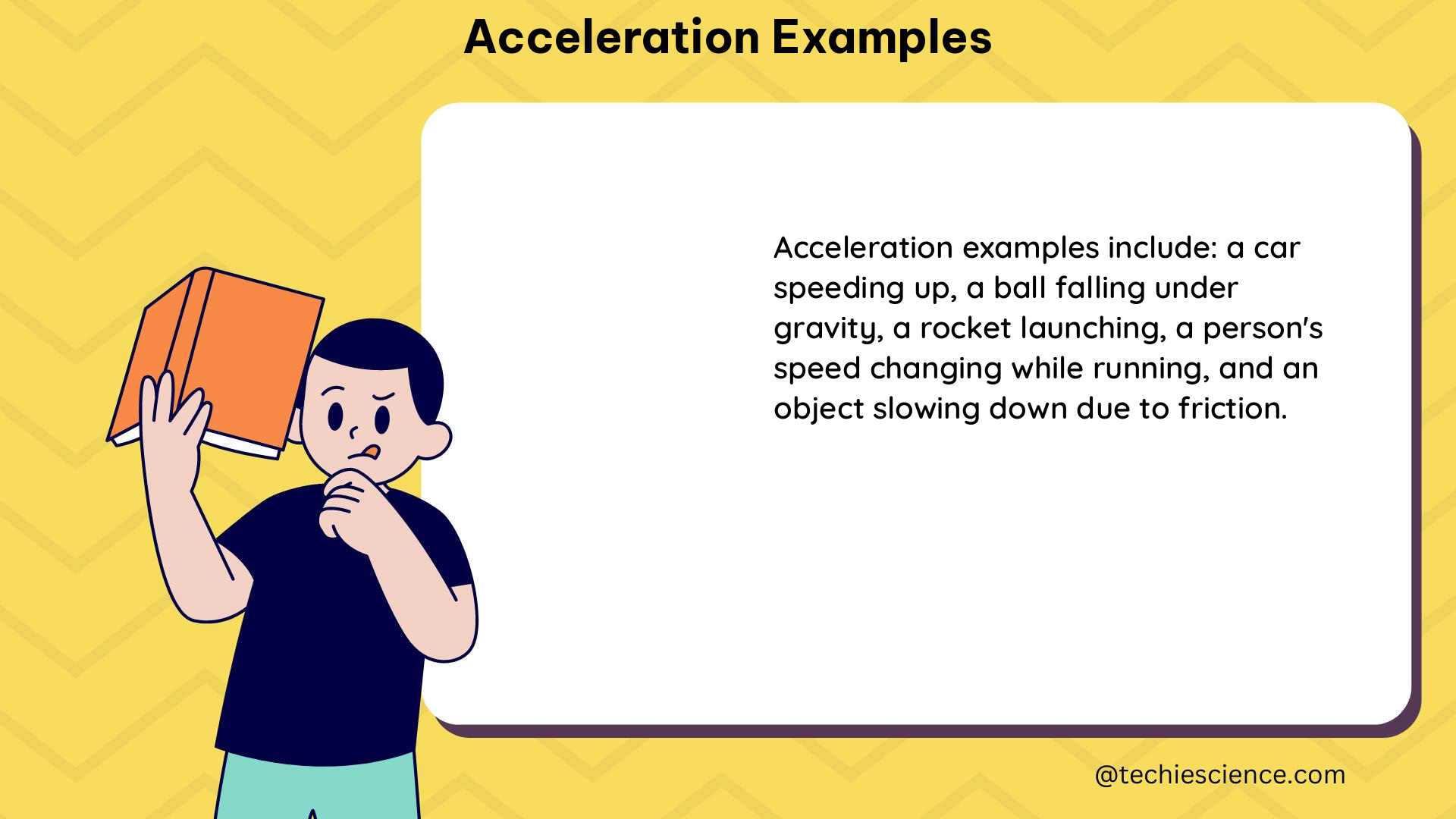Acceleration is a fundamental concept in physics, describing the rate of change in an object’s velocity over time. This comprehensive guide delves into the technical details and practical examples of acceleration, providing a valuable resource for physics students.
Definition and Formula of Acceleration
Acceleration is defined as the rate of change in velocity of an object over time. It is a vector quantity, meaning it has both magnitude and direction. The formula for acceleration is:
a = Δv/t
Where:
– a = acceleration
– Δv = change in velocity
– t = time
Acceleration can be positive or negative, representing an increase or decrease in velocity, respectively. The SI unit of acceleration is meters per second squared (m/s²).
Examples of Acceleration

1. Free Falling Objects
When an object is dropped, it accelerates towards the ground due to the force of gravity. The acceleration of a free-falling object is approximately 9.8 m/s², which is known as the acceleration due to gravity (g). This value can be slightly different depending on the location on Earth and other factors.
The equation of motion for a free-falling object is:
y = 1/2 * g * t²
Where:
– y = vertical displacement
– g = acceleration due to gravity (9.8 m/s²)
– t = time
For example, if an object is dropped from a height of 50 meters, its position and velocity at any given time can be calculated using the above equation.
2. Moving Vehicles
When a car or a train starts moving from rest, it accelerates to reach its cruising speed. The acceleration during this process can be calculated using the formula:
a = (v² – u²) / (2 * s)
Where:
– a = acceleration
– v = final velocity
– u = initial velocity
– s = distance traveled
For instance, if a car starts from rest (u = 0 m/s) and reaches a speed of 20 m/s (v = 20 m/s) over a distance of 10 meters (s = 10 m), the acceleration would be:
a = (20² – 0²) / (2 * 10) = 20 m/s²
Similarly, when a vehicle brakes, it experiences deceleration, which is also a form of acceleration, but in the opposite direction.
3. Projectile Motion
When an object is thrown in the air, it experiences acceleration due to gravity as well as air resistance. The horizontal motion of the object is constant, while the vertical motion is accelerating downwards.
The equations of motion for a projectile are:
x = v₀x * t
y = v₀y * t + 1/2 * g * t²
Where:
– x = horizontal displacement
– y = vertical displacement
– v₀x = initial horizontal velocity
– v₀y = initial vertical velocity
– g = acceleration due to gravity (-9.8 m/s²)
– t = time
For example, if a ball is thrown with an initial velocity of 20 m/s at an angle of 45 degrees, its position and velocity at any given time can be calculated using the above equations.
Technical Specifications of Acceleration Measurement
The measurement of acceleration requires a device that can detect changes in velocity over time. One such device is an accelerometer, which measures proper acceleration, the acceleration felt by an object.
Accelerometer Specifications
- Range: The maximum acceleration that the accelerometer can measure, typically expressed in g-forces (1 g = 9.8 m/s²).
- Resolution: The smallest change in acceleration that the accelerometer can detect, often measured in bits or g-forces.
- Sensitivity: The ratio of the output signal to the input acceleration, usually expressed in mV/g or V/g.
- Accuracy: The closeness of the measured value to the true value, typically expressed as a percentage or in g-forces.
- Linearity: The degree to which the output is proportional to the input, often expressed as a percentage.
- Temperature Sensitivity: The effect of temperature on the accuracy of the accelerometer, usually specified as a change in sensitivity or offset per degree Celsius.
- Frequency Response: The range of frequencies that the accelerometer can measure, typically expressed in Hertz (Hz).
Example of Acceleration Measurement in a Physics Lab
In a physics lab experiment, students can measure the acceleration of a moving cart using a motion sensor. The motion sensor can detect the position, velocity, and acceleration of the cart over time. By analyzing the data, students can calculate the acceleration of the cart and compare it with the theoretical value.
For instance, if a cart is released from rest and travels a distance of 2 meters in 1 second, the acceleration can be calculated as:
a = (v² – u²) / (2 * s)
a = (0² – 0²) / (2 * 2) = 1 m/s²
This value can then be compared to the theoretical acceleration due to gravity (9.8 m/s²) to validate the experimental results.
References
- Acceleration in Sports Medicine: https://sportsmedicine-open.springeropen.com/articles/10.1186/s40798-021-00332-8
- Newton’s Second Law of Motion Examples: https://study.com/learn/lesson/newton%27s-second-law-of-motion-equation-examples.html
- Galileo and Einstein’s Lectures on Acceleration: https://galileoandeinstein.phys.virginia.edu/lectures/gal_accn96.htm
- Newton’s Laws of Motion in the Science Continuum: https://www.education.vic.gov.au/school/teachers/teachingresources/discipline/science/continuum/Pages/newton.aspx
- AP Physics 1 Investigation on Newton’s Second Law: https://www.paulding.k12.ga.us/cms/lib010/GA01903603/Centricity/Domain/525/ap%20physics%201investigation2newtonssecondlaw.pdf

The lambdageeks.com Core SME Team is a group of experienced subject matter experts from diverse scientific and technical fields including Physics, Chemistry, Technology,Electronics & Electrical Engineering, Automotive, Mechanical Engineering. Our team collaborates to create high-quality, well-researched articles on a wide range of science and technology topics for the lambdageeks.com website.
All Our Senior SME are having more than 7 Years of experience in the respective fields . They are either Working Industry Professionals or assocaited With different Universities. Refer Our Authors Page to get to know About our Core SMEs.